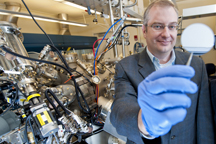Purdue researchers awarded $1 million W.M. Keck Foundation grant
February 6, 2013
 |
|
Purdue professor Michael
Manfra holds a gallium-arsenide wafer as he stands next to the high-mobility
gallium-arsenide molecular beam epitaxy system, or MBE, at the Birck
Nanotechnology Center. Manfra leads a team of Purdue researchers that create
ultrapure semiconductor heterostructures to study electrons in correlated
states. The W.M. Keck Foundation recently awarded the team a $1 million grant.
(Purdue University photo/Andrew Hancock)
|
WEST LAFAYETTE, Ind. — A team of Purdue University researchers has been awarded a $1 million W.M. Keck Foundation grant to create a material that forces electrons into rare states important to basic research and with potential applications for next generation quantum computing.
The Keck Foundation award will help push the research forward at a faster pace, said Tim Sands, executive vice president for academic affairs and provost.
"I am confident that the team will develop the technologies and materials refinements that will lead to a breakthrough in electron mobility, potentially opening the door to new physics, including experimental verification of predicted behavior as well as the first observations of new and unexpected behavior," said Sands, who is also the Basil S. Turner Professor of Engineering and former director of Birck Nanotechnology Center, where the team's work is housed.
The lead researcher is Michael Manfra, the William F. and Patty J. Miller Associate Professor of Physics. He also is an associate professor of materials engineering and associate professor of electrical and computer engineering.
Other team members are Gabor Csathy, associate professor of physics; David Johnson, associate professor of materials engineering; and Kevin Trumble, professor of materials engineering.
The material, ultrapure gallium arsenide semiconductor heterostructures, captures electrons in quantum wells that allow them to zip along without bumping into impurities and scattering, Manfra said.
In ultrapure quantum wells, the electrons only interact with each other, and researchers are able to push electrons within the material into much sought-after "correlated states." When electrons are in a correlated state, a change applied to one is reflected in the motion of all the others. If this behavior could be harnessed and controlled, it could be used to create a new way to store and process information.
The correlated state is like having all of the electrons perform a choreographed dance together, Manfra said.
"We need a perfectly clean and clear dance floor for the electrons because any debris makes them slip and fall or slide off into the tables," Manfra said. "The cleaner, or more pure, the dance floor, the easier it is for the electrons to dance and achieve these new states. We are trying to make the best electron dance floor possible and see what new dances they will perform."
Cleaner starting materials and new growth methods are needed to make semiconductors that can achieve these new correlated states, he said. The Purdue team includes experts in material purification, semiconductor growth and low-temperature electron transport.
"Support from the Keck Foundation allows us to put this team in place and pursue these exciting goals," he said. "Kevin, David and Gabor each bring complementary skills to the work."
Manfra's team designed and built a high-mobility gallium-arsenide molecular beam epitaxy system, or MBE, to create the material. The team has achieved extremely high electron mobility values, which measure how easily an electron can move through a crystal and is used as a metric of the quality of the "dance floor" provided by the material.
Based in Los Angeles, the W.M. Keck Foundation was established in 1954 by the late W.M. Keck, founder of Superior Oil Co. The foundation’s grant making is focused primarily on pioneering efforts in the areas of medical research, science and engineering and undergraduate education. More information is available at http://www.wmkeck.org
Writers: Judith Barra Austin, 765-494-2432, jbaustin@purdue.edu
Elizabeth Gardner, 765-494-2081, ekgardner@purdue.edu
Source: Michael Manfra, 765-494-3016, mmanfra@purdue.edu
Related website:
Manfra research group
Related release:
Material
created at Purdue lets electrons 'dance' and form new state

